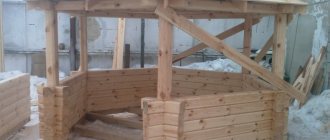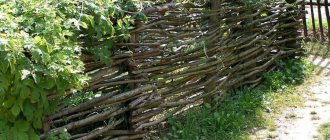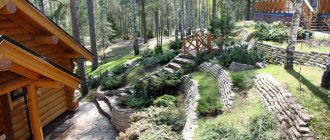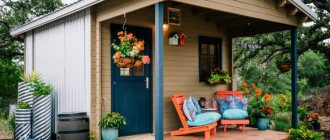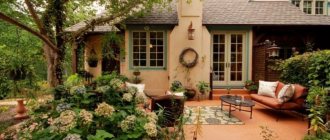Nowadays, owners of their own houses and summer cottages use different varieties of deciduous, coniferous and flowering plants. Recently, the topic of coniferous plantings for hedges was actively discussed on the forum. This is what our regular user Asya1974 writes:
Asya1974
I'm asking for advice. I want to plant 5-7 pieces of Korean fir along the front part of the fence. What I want: a beautiful, always elegant appearance, exactly a coniferous planting. Maybe consider other plants for such purposes? (but you need evergreens).
We have prepared the top 10 evergreen and deciduous plants that are suitable for creating beautiful decorative fences.
Tree or shrub
Some gardeners recommend planting trees on the site. To support their argument, they give the following arguments: larch or birch are characterized by rapid growth and do not require special care.
However, you should take into account that larch creates a large crown over time, and it is impossible to shape it to your liking. The roots of the tree spread widely throughout the site and “pump out” moisture and nutrients from the soil.
A living fence made of bushes has a number of advantages over trees. This:
- compactness;
- the ability to form the desired type of plant;
- Removing bushes requires much less effort than cutting down a tree and uprooting the stumps.
Planting and care
For planting, choose autumn or spring, regardless of whether seedlings or seeds are used. The soil is freed from weed roots and the necessary additives are added (sand, humus, mineral fertilizers).
Principles of planting placement
Seedlings are planted in a row. The distance between plants in a row is 2 times less than with conventional planting:
- for bushes 30-60 cm;
- in trees 1-1.5 m.
The denser the seedlings grow, the more reliable the fence.
Regular haircut
Plants begin to be cut from the second year after planting. In spring and autumn, sanitary (sick and weak shoots are removed) and formative pruning is carried out. The latter is aimed at giving the hedge a certain shape and enhancing the tillering of plants.
Molded plantings
To give plants a strict geometric shape, special templates are used.
To give the crown density, the main shoots are regularly cut, encouraging dormant side buds to grow. The procedure is carried out up to 2 times per season.
Unshaped hedge
A sanitary haircut twice a year is enough.
Pest and disease protection
Treatment with insecticides and fungicides will help protect plants from diseases and pests. For rot and fungal diseases use: Fufanon, Strobi, Profit Gold.
They will save you from pest invasion: Akarin, Kinmiks, Aktara.
Care Tips
It is better to feed a hedge by spraying it on the leaf.
It is recommended to thin out particularly dense hedges to allow light and air into the crown.
Useful trees
If you really want to plant not just plants for a fence, but trees on your site, then we recommend those that will bear useful fruits.
Such trees primarily include cherry and viburnum.
The benefits of a living fence
The greatest advantage of a hedge made of trees and shrubs is that it purifies the air and provides additional oxygen.
Plants of various types can be planted for such a fence:
- coniferous and deciduous trees;
- curly;
- high or low;
- densely or sparsely growing.
If you don’t want to become the object of immodest glances, plant tall plants in two rows. Low-growing shrubs are more suitable for framing flower beds.
Making a choice will not be difficult. On the Internet you will find photos of a living fence to suit any, most sophisticated taste.
Conifers
A hedge made of coniferous trees is the most popular solution, loved by both landscape designers and property owners. This is due to a number of advantages:
- Preservation of decorative appearance throughout the year.
- The dense crown, naturally or with little effort for proper formation, is practically impenetrable.
- Most species have spiny needles, preventing both people and animals from entering the area.
- Adaptability to various conditions (soils, humidity, gas pollution, etc.).
Coniferous trees of almost all known species are used in hedges.
Thuja
One of the best options for single-row medium and tall hedges.
Received recognition thanks to a unique set of properties:
- The crown has a columnar or slightly conical shape, the first tiers of branches are formed almost at the surface of the ground. Requires minimal effort to create and maintain the required shape.
- It tolerates molding pruning well, the crown thickens quickly.
- Not demanding on soils, resistant to gas contamination and dust.
- Belongs to breeds with a low or medium growth rate, as a result of which the fence retains its appearance and function for 30 years or more.
- Looks good all year round.
Among the shortcomings, we can only highlight the necessity:
- plant sufficiently mature seedlings;
- protect needles from sunburn.
Thuja occidentalis is mainly used:
fast growing Brabant
columnar Smaragd
decorative Rheingold
Rheingold with colored needles - golden in summer and bronze in winter, pink on young shoots.
Spruce
An excellent choice for living exterior fencing.
A dense crown forms close to the ground, and the prickly needles effectively prevent even small animals from entering the area. Tolerates pruning well.
Prickly spruce and common spruce (European) are excellent for tall single-row hedges.
For medium-height fences, slow-growing, low-growing varieties of Canadian spruce are often used.
Most species tolerate being in the shade well, but require a sufficient level of general illumination for optimal development. They are unpretentious, adapt well to the composition and humidity of soil and air, and average annual temperature changes. They feel great throughout Central Russia.
The disadvantages include:
- demands on soil nutrition, especially at a young age;
- shallow root system, which makes trees unstable in strong winds;
- sensitivity of needles to the spring sun (requires protection from burns).
Fir
A tree with flat and soft needles and vertically growing cones, which provides it with a magnificent decorative appearance. The crown is dense, the first tiers of branches are formed almost at the surface.
It tolerates pruning without problems, but it is preferable to use the tree not in molded hedges, but in free-growing hedges. Due to the cone-shaped crown, the hedge looks very attractive.
It is practically not demanding on the soil, but prefers fertile loams. Easily tolerates changes in humidity and temperature, and gas pollution in an urban environment.
Fir is ideal for hedges in the Middle Zone:
Sakhalin
Kamchatka
Siberian
balsamic
One of the main advantages of the breed is the active release of phytoncides and essential oils, which has a positive effect on the atmosphere in the area and the health of the owners.
Juniper
Most types of junipers are shrubs and are used in the organization of medium-height hedges and borders.
However, the tree-like varieties of common and virgin juniper are excellent for single-row fencing.
Due to a growth rate below average (up to 10 cm per year), hedges are formed that last for 30-40 years.
Moreover, both of these species tolerate pruning well and easily form a columnar, cone-shaped, or ovoid dense crown with excellent masking and enclosing properties.
At the same time, juniper also has other advantages. Among them are sustainability:
- To droughts and humidity changes.
- Low temperatures and their significant differences.
- Smoke, gas and dust levels in the air.
- Soil composition (the best option is with a slight acid reaction).
Plants demonstrate soil-forming and soil-protective abilities. Rich in essential oils, they provide air deodorization and have a beneficial effect on health.
The main drawback is that all junipers are light-loving. The only species that tolerates light shade is the common juniper.
Cedar and pine
They have similar properties - high crown location, spherical shape. They grow quite quickly and reach a respectable height.
Therefore, the preferred use of mature trees is the upper tiers of combined multi-tiered fences.
For hedges up to 3m high, young plants are suitable, the crown of which starts almost at the ground and is distinguished by significant density. Pruning produces virtually no thickening, so trees are not used in molded hedges.
Among the main advantages:
- Unpretentiousness to conditions (humidity, soil composition, temperature changes).
- Resistance to pollution and gas contamination of urban air.
- Excellent decorative properties due to different shades of needles and bright shoots.
All types of cedars can be planted in the middle zone - Lebanese, Himalayan, Atlas, mountain, Siberian, cedar, black pine.
Yew berry
This European look is one of the main ones in landscape design. This popularity was ensured by him:
- Excellent cutting tolerance. After pruning, the crown quickly thickens and holds any shape well. This is why yew has become a favorite material for living sculptures in the classic English garden. Varieties with a pyramidal crown easily form a dense molded hedge
- Low growth rate. A yew fence will last for more than 50 years without problems or renovation.
- Decorative properties. The tree looks great almost all year round, from the flowering period until the bright pine cones remain on the branches.
In addition, yews:
- Shade-tolerant (superior to any other tree species);
- Frost-resistant;
- Resistant even under strong wind influences;
- They can easily withstand urban conditions (gas pollution, smoke, dust).
The only serious drawback is toxicity (almost all parts of plants contain substances dangerous to humans). Therefore, this tree should be used with caution in areas where children are constantly present.
The lifespan of yew berry can reach four thousand years. Therefore, a hedge made from this tree will easily please 2-3 generations of site owners with its appearance.
Lavsana cypress
One of the most popular species for hedges in Europe.
It has many varieties, differing in the natural shape of the crown (pyramidal, conical, columnar), and the color of the needles.
Cypress tolerates molding pruning well, the crown quickly thickens and retains its shape well. At the same time, it does not lose it even during the period of rapid growth (after 5 years).
Numerous root shoots contribute to the creation of an insurmountable barrier.
In addition, the tree:
- Easily tolerates drought;
- Not demanding on soil nutrition;
- Resistant to urban conditions.
For Central Russia, it has a serious drawback - it does not tolerate severe frosts (with air temperatures below -20°C), and therefore requires additional protection.
Plant selection
In order to answer the question of how to make a living fence, you must first decide which plants are best suited for planting in your garden.
A living fence can be formed from the following plants:
- wild grapes;
- thuja;
- vesicular carp.
When choosing between evergreen and deciduous plants for a hedge, keep in mind that pine and spruce trees take a long time to grow. Deciduous ones do not fulfill their purpose in the winter, and in the fall they can significantly clog the area of the site.
Wild or maiden grapes are used to create a vertical hedge.
Thuja doesn't grow too close, but creates a nice tight fence.
Growing a bladderwrack bush in the garden is not difficult. It grows quickly, is unpretentious, and tolerates increased air pollution.
It can be planted as a separate bush, or as a whole row, forming a living fence. It has very beautiful leaves. The color depends on the plant variety. There are shrubs with green, burgundy and yellow foliage.
How to plant a hedge and care for it
In order for a hedge to turn out beautiful, healthy and durable, it must not only be planted correctly, but also carefully looked after. Let's look at the main points to pay attention to.
Landing
After the plants necessary for the hedge have been purchased and delivered to the site, planting them in the ground begins. The planting depth depends on the root ball (should be specified depending on the type), watering and fertilizing are standard (before planting, the bottom of the hole should be spilled with water, a little compost should be added, then another watering after the plants are planted).
[!] Advice from experienced gardeners. Do not dig individual planting holes, but rather a trench. This way, the planting depth will be the same for all plants, and the work will take less time and effort.
Another important nuance is the distance between individual plants. For each type there are recommended norms, which, if we are talking about hedges, it is advisable to reduce by 20%. This will create a denser green fence.
Trimming
To make a hedge look beautiful and neat, it needs to be trimmed several times a year:
- In early spring, before the fruit buds set;
- In summer - evergreen species and plants that have active sap flow in the spring, that is, those for which spring pruning is contraindicated;
- In autumn - usually berry bushes that begin the growing season in early spring.
[!] Advice from experienced gardeners. Some types of conifers do not tolerate radical pruning. They need to be cut very carefully - no more than a third of the length of the branch in small sections in several approaches on a dry sunny day.
Hedge repair
A hedge can lose its decorative effect for several reasons:
- Exposure of the lower part (trunks) of adult plants;
- Freezing of hedgerow areas;
- Damage to a part of the plant by pests or diseases;
- Damage or death of individual specimens due to improper care.
Such a fence, of course, will not only cease to please the eye, but will also not fulfill its main function - protecting the site from uninvited guests. However, there is a way out - repair.
To cover the bare trunks of elongated trees or shrubs, plant a row of low-growing perennials in front of the hedge. They will hide the gaps. In addition, the lower openings can be disguised with decorative tubs (and beautifully flowering annuals planted in them every year) or low lattice structures along which to grow vines.
If, due to damage to the plant, the gap is the entire length of the hedge, proceed a little differently. The easiest way is to replace the dead specimen with a new one, preferably of the same type, age and height. In cases where this option is not possible, the hole can be closed with a new plant, for example, a flowering one or a coniferous one in a series of decorative deciduous ones, thus creating an interesting landscape composition.
Another option is to build a decorative column in place of the missing plant, along which to grow a vine, or to place a lantern, sculpture or bench. That is, to dilute the green hedge with a man-made element, which, moreover, can perform a very practical function.
In general, there is nothing wrong with damaging part of a hedge. This problem can be easily solved using quite accessible means. *** Growing a green hedge and caring for it is not at all difficult, but how many wonderful emotions this island of wildlife can give. So maybe it's time to give up boring, monotonous fences and replace them with real beauty? Well, the choice is yours.
Berry bushes
A hedge of fruit-bearing shrubs will be not only functional, but also very useful. Want to get healthy berries? Then plant:
- raspberries;
- rose hip;
- blackberries;
- barberry;
- currants (red, white or golden).
Such plantings require systematic care. Shrubs for the garden should be pruned. This way they will look much more attractive and, moreover, the harvest of berries is much easier.
It is not recommended to plant such plantings along the road. Or rather, it is possible, but you should remember that all the harmful elements of exhaust gases “settle” in the berries. So you can't eat them.
Classifications
Hedges are divided into several groups, depending on the height, shape and species composition of the composition. Each group has its own characteristics of care and serves to perform different tasks.
By plants used
According to the type of plants included in the composition, fences are:
- deciduous (dogwood, euonymus, maple, barberry);
- blooming (spirea, lilac, mock orange, rose hips);
- evergreens (conifers);
- climbing (hops, maiden grapes).
There is a practice of creating fences from fruit bushes and trees: currants, gooseberries, cherries, ranetka apple trees. Such a fence, in addition to its protective function, plays the role of a supplier of berries and fruits.
By composition and structure
A hedge can be made up of plants belonging to the same species and variety. This composition is called “uniform”, and is popular in classical and regular gardens.
Combined hedges are planted with plants of different species. Growing up, they imitate the natural landscape, organically combining in height, crown density and foliage color.
Climbing plants are used in the construction of “trellis” structures. Flexible shoots are evenly distributed over the base (metal or plastic mesh, wooden sheathing), intertwining with each other.
By height
Living fences are classified according to height into 4 types:
- border (height up to 40 cm);
- low (up to 100 cm);
- medium (from 100 to 150 cm);
- tall (over 150 cm).
Low and medium fences are made up of shrubs, high fences are made up of trees (oak, linden, maple, lilac).
By planting technique
A living fence can be artificially formed and freely growing.
Using systematic trimming, hedges with a clear crown geometry are created. They look impressive, but require regular pruning throughout their life.
When forming freely, plant branches are not subjected to formative pruning. For this type of fencing, crops with a beautiful natural crown shape are selected. They only require sanitary pruning.
Blackberry
Very often, gardeners use blackberries as a fence plant. It does not grow without watering, but can withstand the most severe frosts. With proper care it produces a bountiful harvest. With its thorns it protects the area from uninvited guests.
However, it is the thorns that interfere with harvesting. If new shoots are not trimmed in time, the blackberry bush will look rather unattractive.
Boxwood - ease of molding
The tetrahedral leaves of boxwood are close to each other, forming a dense crown. After flowering, fruits appear on it. Among the variety of species, varieties with monochromatic and variegated colors, dwarf and tall varieties are distinguished.
Slow growth and ease of trimming make the shrub an excellent option for arranging a green fence that does not require frequent maintenance. Boxwood grows best in partial shade. The more often the shoots are pruned, the more intense the feeding should be. Watering is required only in hot weather and drought. Regular loosening of the soil ensures air flow to the root system.
In open sun or insufficient lighting, the plant develops slowly and may die. Boxwood is afraid of drafts and severe frosts. In order for the plant to tolerate the winter well, in the fall the bush must be covered with burlap, this will protect the boxwood from bright sunlight and cold.
Currant
Forms dense but low rows. Therefore, you should choose a suitable location based on the height of the plant.
Barberry
We recommend paying attention to this shrub. True, it does not grow quickly, but in a few years the plant will create a two-meter impenetrable living fence in the country with huge thorns.
In the fall, barberry will delight the owners of the dacha with a bountiful harvest and purple foliage. The shrub does not sprout and there is no need to waste time and effort on cutting off excess shoots.
Blood-red hawthorn - an unpretentious long-liver
This deciduous shrub becomes a decoration of the site for decades. In spring it is covered with delicate inflorescences. Carved leaves and bright red berries, which form in autumn, also decorate the hawthorn fence.
The shrub feels comfortable in dry summer weather, tolerates low winter temperatures, and develops well in areas of the garden where sunlight penetrates with difficulty. It is not necessary to water the bushes. Hawthorn responds to pruning and actively produces new shoots, making it possible to create a continuous green wall. Cuttings take root well, so hawthorn propagates very easily.
The disadvantage is that the lower part of the bush is exposed as it grows. To avoid this, formative pruning should be done regularly.
Raspberries
It grows up to two meters and produces tasty and healthy berries. You should watch out for shoots, which can make the hedge denser, but will “take away” the strength of the fruit-bearing branches and reduce the yield.
Knowing all the pros and cons of fruit-bearing shrubs, choose the one that best suits your desires and lifestyle.
Turf
The shrub grows quickly. Reaches a height of three meters and forms dense thickets. Easy to "haircut".
In winter, the foliage falls and the bush loses its decorative effect.
Before planting turf, you should make sure you have water for irrigation. The plant loves water very much.
Lilac - the luxury of flowering
In late spring and early summer, lilac fences are strewn with delicate flowers and exude a scent that many associate with the onset of the warmest time of the year. For hedges, it is better to choose frost-resistant varieties that are drought-resistant and easy to care for. Amur, Hungarian, and Mayer lilacs are ideal.
The advantage of such bushes is their resistance to diseases. They are not affected by harmful insects. Caring for lilacs is not burdensome; formative pruning of branches is sufficient. Every year it is also necessary to remove young shoots that begin to grow next to adult bushes.
The disadvantage of such a fence is that after a short flowering, the lilac loses its decorative effect. However, the beauty of lush flowers compensates for this shortcoming.
Flowers
A living fence in the country can be formed from lilac, jasmine or rose.
Lilac grows very quickly. A very unpretentious shrub with beautiful and pleasantly smelling flowers.
Practically not susceptible to diseases. Produces abundant growth, which should be systematically removed. Without trimming the branches it can reach a height of three meters.
Chubushnik crown - tenderness of aroma
This profusely flowering shrub grows up to 3m in height and its ability to grow quickly even after soft branches are cut back to half its length makes it an ideal choice for creating a tall hedge. Thanks to its bright green leaves, the bush retains its attractiveness even after flowering.
The advantage of jasmine is that it is frost-resistant and easy to care for, so it is perfect for growing in the climatic conditions of the middle zone. Long-lasting abundant flowering and delicate aroma are also its advantages.
To reveal the full potential of the plant, you need to choose a place with good lighting for planting it. It is better if the soil is not compacted or waterlogged.
Rose
Most people consider the flower to be capricious and heat-loving, just like a queen should be. In fact, many frost-resistant varieties have been developed today. Some of them can withstand temperatures down to minus 40º C!
The so-called park roses can be used to form a beautiful living fence.
Creating a trellis fence
A trellis fence is a godsend for small areas. It is formed from willow, acacia, hawthorn, and rowan.
Trellis hedge
Step-by-step instruction:
1Seedlings are planted at intervals of 20 cm.
2After a year, the plants are pruned. Only a stump of about 15 cm is left.
3In the second year, pruning is carried out again. It is necessary to leave strong shoots and remove the rest.
4The left shoots intertwine with each other. You must maintain an angle of 45 degrees. The bark at the points of contact is removed.
5The diamond pattern needs to be secured. For this, a frame is installed.
6When side shoots appear, they need to be cut off. Pruning is carried out about 3 times during the season.
7To ensure that the hedge is of the required height, the tops of the trees are also trimmed.
Photo of a living fence
Total
Category: Fence and gates



